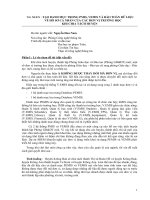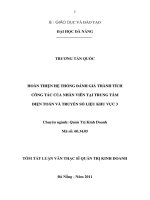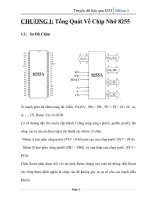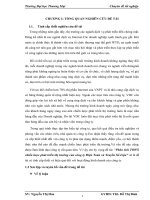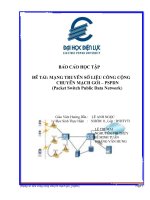Ch30 TRUYỀN SỐ LIỆU VÀ MẠNG
Bạn đang xem bản rút gọn của tài liệu. Xem và tải ngay bản đầy đủ của tài liệu tại đây (1.08 MB, 54 trang )
Chapter 30
Cryptography
30.1
Copyright © The McGraw-Hill Companies, Inc. Permission required for reproduction or display.
30-1 INTRODUCTION
Let us introduce the issues involved in cryptography.
First, we need to define some terms; then we give some
taxonomies.
Topics discussed in this section:
Definitions
Two Categories
30.2
Figure 30.1 Cryptography components
30.3
Figure 30.2 Categories of cryptography
30.4
Figure 30.3 Symmetric-key cryptography
30.5
Note
In symmetric-key cryptography, the
same key is used by the sender
(for encryption)
and the receiver (for decryption).
The key is shared.
30.6
Figure 30.4 Asymmetric-key cryptography
30.7
Figure 30.5 Keys used in cryptography
30.8
Figure 30.6 Comparison between two categories of cryptography
30.9
30-2 SYMMETRIC-KEY CRYPTOGRAPHY
Symmetric-key cryptography started thousands of years
ago when people needed to exchange secrets (for
example, in a war). We still mainly use symmetric-key
cryptography in our network security.
Topics discussed in this section:
Traditional Ciphers
Simple Modern Ciphers
Modern Round Ciphers
Mode of Operation
30.10
Figure 30.7 Traditional ciphers
30.11
Note
A substitution cipher replaces one
symbol with another.
30.12
Example 30.1
The following shows a plaintext and its corresponding
ciphertext. Is the cipher monoalphabetic?
Solution
The cipher is probably monoalphabetic because both
occurrences of L’s are encrypted as O’s.
30.13
Example 30.2
The following shows a plaintext and its corresponding
ciphertext. Is the cipher monoalphabetic?
Solution
The cipher is not monoalphabetic because each
occurrence of L is encrypted by a different character.
The first L is encrypted as N; the second as Z.
30.14
Note
The shift cipher is sometimes referred to
as the Caesar cipher.
30.15
Example 30.3
Use the shift cipher with key = 15 to encrypt the message
“HELLO.”
Solution
We encrypt one character at a time. Each character is
shifted 15 characters down. Letter H is encrypted to W.
Letter E is encrypted to T. The first L is encrypted to A.
The second L is also encrypted to A. And O is encrypted
to D. The cipher text is WTAAD.
30.16
Example 30.4
Use the shift cipher with key = 15 to decrypt the message
“WTAAD.”
Solution
We decrypt one character at a time. Each character is
shifted 15 characters up. Letter W is decrypted to H.
Letter T is decrypted to E. The first A is decrypted to L.
The second A is decrypted to L. And, finally, D is
decrypted to O. The plaintext is HELLO.
30.17
Note
A transposition cipher reorders
(permutes) symbols in a block of
symbols.
30.18
Figure 30.8 Transposition cipher
30.19
Example 30.5
Encrypt the message “HELLO MY DEAR,” using the key
shown in Figure 30.8.
Solution
We first remove the spaces in the message. We then divide
the text into blocks of four characters. We add a bogus
character Z at the end of the third block. The result is
HELL OMYD EARZ. We create a three-block ciphertext
ELHLMDOYAZER.
30.20
